While I thought a book vending machine was a strange one-off from the past, Steve Portigal sets me straight with this pic he took at Heathrow just last November:
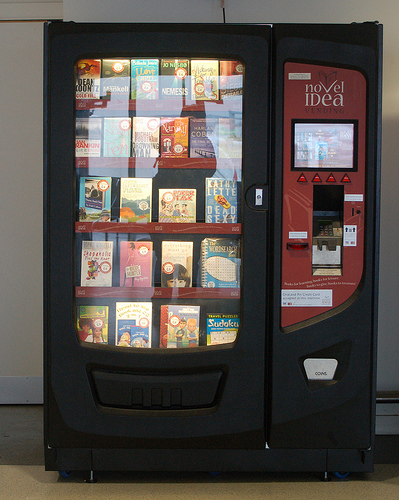
Pic by Steve Portigal, click for more.
This post is part of an occasional series.
Posted Under:
Things/Thinking by Rob Walker on May 5, 2010
Comments Off on Books, the idea: Contemporary vending machine example
Over at Hilobrow, Matthew Battles makes an interesting point about ROFLCon. (Well, he makes several, but I’m only going to address one of them here. Read his whole writeup here.) In the panels he attended, he notes: “Too often the tone was, ‘turn your snarky web site into a book — or even a TV show!'”
There’s a lot of truth in that — many of the meme-makers and Internet celebs and other proprietors of what was being celebrated as outsider weirdness got a hearty round of applause upon noting their recent book deal or other cash infusion from the trad media. This is interesting in part because it suggests that if there’s a ROFL subculture, it’s not exactly standing in opposition to the fabled MSM, despite rhetoric to the contrary. (Surely this relates to my uncertainty about what that ROFLCon attendee was getting at with her accusatory “Seriously? The New York Times?” blurtage.)
To be fair, there were also stories of turning away MSM overtures that were particularly insipid, and more than one ROFLmaker seemed to take the attitude that they were better off going with a more autonomous monetization strategy (selling ads, selling merch direct to fans, etc.). The point is that I’m not sure if MSM represents a sanctifying force in ROFLCulture — or simply a source of ready money. (Money that ROFLmakers may see as a no more than a dumb windfall.) Or some of each.
Too many links. This is what happens when I skip a linkpile post. Sorry.
- Top Executive Declares That NYT, Using Personal Data, Must Turn Its Readers Into “Leverageable Assets.”: “Identity is, in my view, a fundamental building block for engagement.”
- Promiscuous online culture and the vetting process: “At the intersection of promiscuous online culture and easy access to search lies a world where it’s impossible to hide. And these days, you look suspicious for trying, or even forgetting something innocently.” I agree with Marginal Utility — this post describes a terrifying drift.
- The Safety of Objects: Design and “Inverted Totalitarianism”: “A symptomatic reading of Objectified reveals an urge for impeccable order, an incurable desire to purge from public view the irregular, the odd, the heteroclite, and even the excessively ornate or strictly utilitarian, in order to place in their stead a whole array of everyday things boasting clean lines and soothing orbicularities — a regime of Platonic functionality, in other words, vouchsafed to an auxiliary of designers equipped with the latest drafting software and laser-guided precision instruments. Objectified comes across as a fever dream of the sort which brings the sufferer visions of the world to come: namely, the dictatorship of the creative class.”
- Some Twitter data: 87 percent of Americans are aware of it. 7 percent use it. Facebook has similar awareness, six times as many users. Just over half of Twiter users don’t tweet, they just treat it as “broadcast content.” 24 percent of Twitter users are African American.
- Costco prank: Shopdrop variation: Shelf tags for fictional objects stuck in Costco. Okay.
- Los Angeles Times Adds Paid Links in Articles – Media Decoder Blog – NYTimes.com: “These post-publication links to sites such as Amazon and TicketNetwork will serve as both a reader service and a revenue opportunity for the company.” Via PSFK.
- When multi-tasking, each half of the brain focuses on different goals | Not Exactly Rocket Science | Discover Magazine: Researchers “have found that the part of our brain that controls out motivation to pursue our goals can divide its attention between two tasks. The left half devotes itself to one task and the right half to the other. This division of labour allows us to multi-task, but it also puts an upper limit on our abilities.” Didn’t we know this already?
- The Evolution of Advertising in Sports Video Games: From 1983 to 2006.
- Play’s the Thing: “A new book argues that play may be the primary means nature has found to develop our brains.”
These links compiled via delicious, and repurposed here with plug-in Postalicious. Not enough stuff? Not the stuff you wanted? Try visiting unconsumption.tumblr.com, murketing.tumblr.com, and/or the Consumed Facebook page.
Posted Under:
Non-Daily Linkpile by Rob Walker on May 4, 2010
Comments Off on (0verflowing) Linkpile
These stress balls…
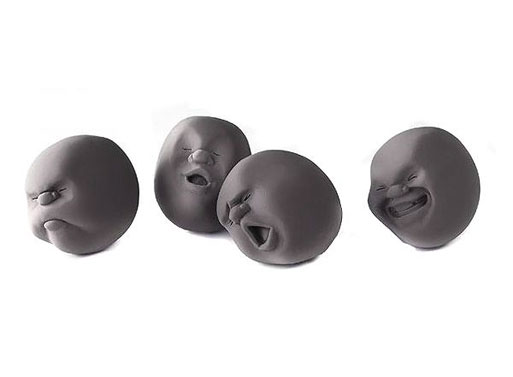
$152; click for more.
… remind me of the Makapansgat Pebble (discussed here):

The Birth of Want. Click for more.
Following up this post, and this one, another take on the stand-by color bars pattern:

Stained Glass Test Pattern on Make site; click for more.
Nice!
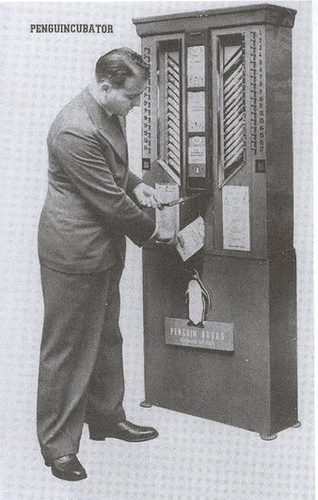
Penguincubator. Click for more.
This made the rounds recently, I believe originating with this piece on Publishing Perspectives, about Allen Lane, best known for devising the first breakout success cheap-but-quality paperback, for Penguin. Evidently Lane also dreamed up the device above: The Penguincubator, a book vending machine from the mid 1930s.
First installed outside Henderson’s (the “Bomb Shop”) at 66 Charing Cross Road, [it] signaled [Lane’s] intention to take the book beyond the library and the traditional bookstore, into railway stations, chain stores and onto the streets. It is worth noting, given publishers’ frequent timidity in this area, that this really annoyed booksellers. (Lane’s lack of trepidation is an important part of this story; worth noting, too, that he was the first English publisher of James Joyce’s Ulysses, at the Bodley Head, despite the widespread contemporary fear of prosecution for obscenity.)
In the Penguincubator we see several desires converge: affordable books, non-traditional distribution, awareness of context, and a quiet radicalism. And it’s not a huge leap of the imagination to see how these apply now. I see the same bored gaze on the bus and tube today, as people reflexively flip open their phones and start poking at email or casual games, as Allen Lane saw on the platform at Exeter in 1933. And slowly — oh, so slowly — publishers are seeing that what we are presented with is not the death of everything we trust, value and hold dear, but a similar widening vista of opportunity to that which arrived with the mass-market paperback.
I couldn’t find out much more — like the fate of this fascinating object — but there was another picture of it on Flickr, situated next to a “Bikini Automat.”
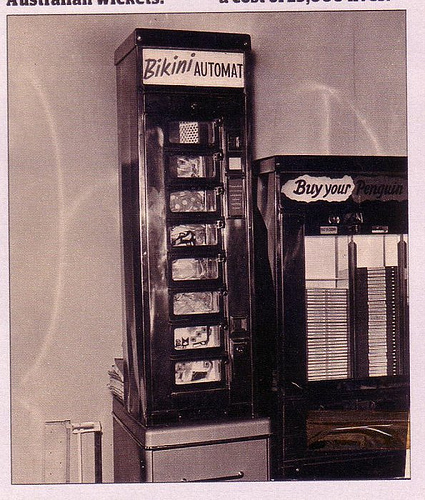
From Flickr user Mags. Click for more.
This site was quiet the last couple of days because I was out of town, attending ROFLCon. If you’re not familiar with this event, it’s devoted to Internet memes, Internet celebrity, weird online culture & phenomena, etc. The guest list here.
I’m not big on conferences, but obviously this one is … unusual. And I had a great time. Among other things I got to meet a couple of people I’ve written about in the past. One was imaginary brand impresario Pete Hottelet, who has the coolest business card I’ve ever seen, and who in general turned out to be a really nice, smart, and fascinating guy. I interviewed him via phone a while back in a column about Brawndo; he’s now also putting out the real-world version of Tru Blood, and will soon release another defictionalized product that I’ll write up here later. The other was Jef Sewell, one of the founders of Despair.com (I wrote about that here), who had some really great stuff to show off, including the company’s lavish new edition of Charles Ponzi’s memoir.It looks rather impressive; I think Sewell and his brother Justin have one of the most interesting businesses around.
I also got to meet a bunch of people I’ve interviewed for stuff that’s forthcoming, plus see some old friends, meet some new friends, and so on. There were several really good panels, and I have one or two thoughts from those that I’ll try to articulate here soon.
Anyway I also had one really weird moment, which I guess isn’t too surprising at this sort of event. Everybody had lanyard name tags on and of course mine said “New York Times” on it, because, you know, even though I’m not on staff, that’s my main client or venue or whatever you want to call it. I usually don’t think about this very much, but as I was leaving one panel, a young woman walking past me as she exited looked at my name tag and blurted out an incredulous: “Seriously?? You write for The New York Times?”
She sounded sort of appalled, or maybe alarmed, and possibly just a little bit hostile.
I had no idea what to say. Partly because I wasn’t sure what she meant. Was there something really unlikely about me, as a physical human being, writing for the Times? Or did her incredulity have to do with the idea that someone from The Times might be attending this event? If the latter, was she appalled that The Times would devote attention to stuff that’s so silly/weird/obscure? Or was it more like, “Oh what a bummer that the Times is here to ruin our cool subculture”? Again: I didn’t know what to say. Of course I’ve already written about several of the guests here, and I’ve interviewed many others. I’m sure the Times in general has covered many others. Basically I was so startled, but her tone more than anything, that I just stood there, mute.
And she kept walking. So that was that.
ROFL?
 UNIFORMITY
UNIFORMITY
The retailing of a representation of a faux-authentic uniform
In March, Burton Snowboards announced that later this year it would begin selling pants similar to those worn by the U.S. Olympic snowboarding team. There is a logic to this move, because the most notable thing about the team’s uniform was how much it looked like a trendy retail product….
Read the column in the May 2, 2010, New York Times Magazine, or here.
Discuss, make fun of, or praise this column to the skies at the Consumed Facebook page.
Posted Under:
Consumed by Rob Walker on May 3, 2010
Comments Off on In the NYT Magazine: Burton’s Olympic pants go retail
This, apparently, is a physical representation of a digital (video game) representation of a Coke can. The artist (Ashley A on Flickr) writes:
While playing Bad Dudes, I killed a ninja, who upon dying dropped a 5 x 9 pixel powerup; that powerup, despite its incredibly small size, was instantly recognizable as a Coca Cola can. It blew my freaking mind!!! I was in love.
This particular image is the first iteration in a series exploring this super-reduced icon of an Icon (with a capital “I”) in various media.
Via Not A Real Thing.
Posted Under:
Artists,
Things/Thinking by Rob Walker on April 29, 2010
Comments Off on Digital representation, made physical
This was one of my favorite column topics ever. I still see donks around town here in Savannah, and other points south. I don’t see as many with exciting brand-inspired themes, though. Then yesterday I saw this excellent Cap’n Crunch donk on Flickr, I believe taken in Little Rock:
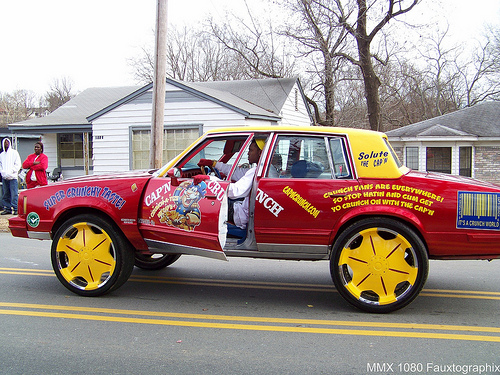
Pic by 1080Graphixdesign
Then after poking through some Flickr pools, this from Greenville, AL:
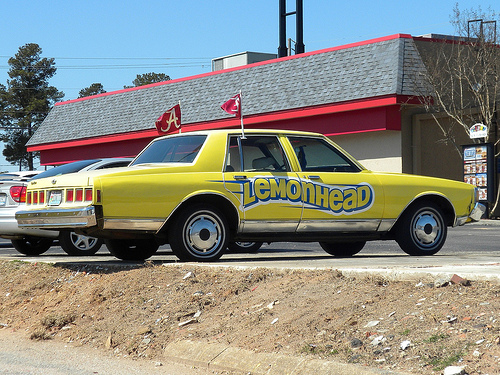
Pic by Katie and Joe
Great stuff.
Posted Under:
The Designed Life,
Update by Rob Walker on April 29, 2010
Comments Off on Another random consumed update: Themed-out donks
Recently I had a column about object utility using the ax, through history, as an example. Recently this super-functional ax came to my attention:
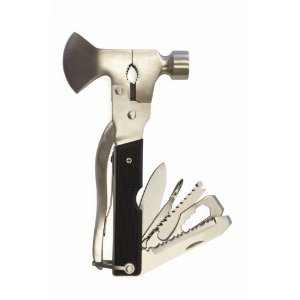
This reminds me of the kind of excess of functionality that characterizes certain tech gizmos: That is, it’s not so much about how you’ll use all the functions, it’s more about signally (largely to yourself) about all the functions you MIGHT and COULD use, at some point.
Posted Under:
Update by Rob Walker on April 28, 2010
Comments Off on Consumed Update: Ax functionality
Given my interest in Things That Look Like Other Things, it’s inevitable that some would pop up in this series.
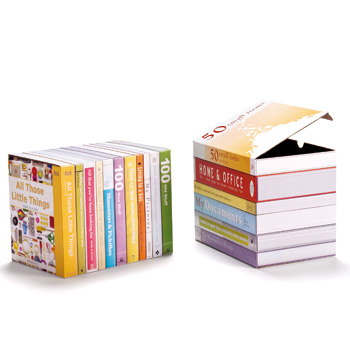
Boxes That Look Like Books. Click for more.
Bookshelf blog reports: “Designed by Peleg Design. Printed cardboard boxes for elegant storage on book shelves.”

Shelf That Looks Like A Book. Click for more.
Note the title of the bottom “volume.” Bookshelf blog notes that it is actually “a small shelf with the appearance of a book.”
Posted Under:
Products,
The Designed Life by Rob Walker on April 28, 2010
Comments Off on Books, the idea, cont’d: This is not a book.
I’m still poring over the delightful Bookshelf blog, but here’s a little bit to add to this occasional series of posts.

By Hans Feldman
Bookshelf says: “‘Bookshelves’ is a 5-panel, life-size photograph of Feldmann’s own bookshelves at his home in Düsseldorf.”
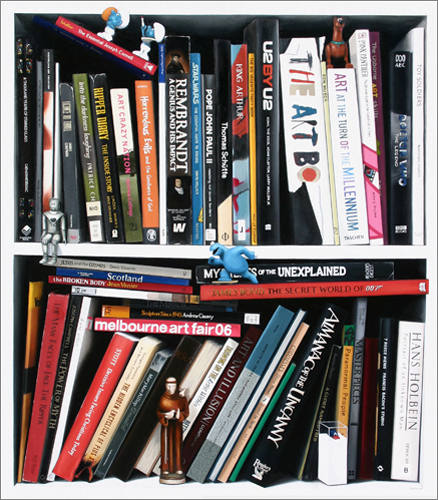
"Alasdair Macintyre," by Victoria Reichelt; click for more.
Apparently this is an oil on canvas piece, one several made by Victoria Reichelt. Bookshelf quotes her:
While some of these bookshelf paintings are of random books, I’ve recently done a series that are portraits of people. So I’d go to their houses and photograph their bookshelves and then make paintings from the photos as a way of telling the viewer about the person.
She also made this series of color-grouped books, which I think are pretty stunning:
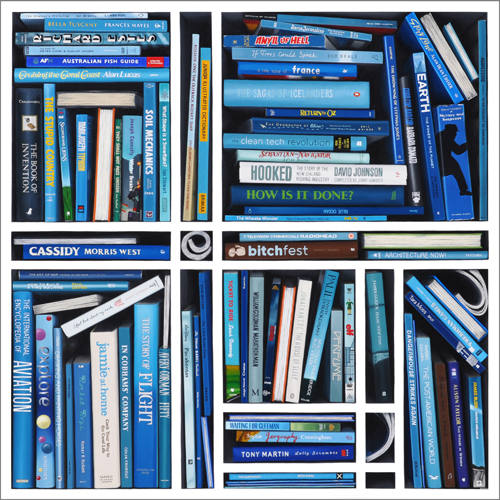
"Blue Ocean," by Victoria Reichelt, click for more.
Posted Under:
Artists by Rob Walker on April 27, 2010
Comments Off on Books, the idea, cont’d: Spines as art
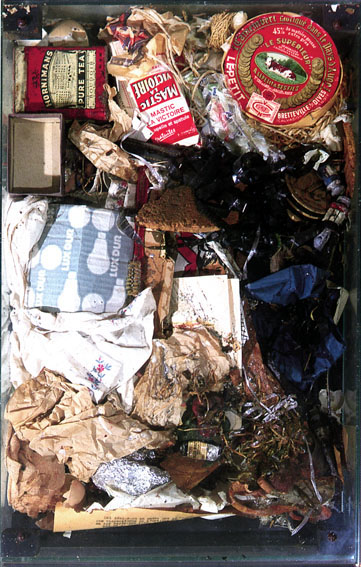
By Arman. Click for more.
Via EverydayTrash. This is household trash, in a glass box, photographed by a French artist named Arman. More info here and here.
Mildly related: Justin Gignac’s garbage in a box.
This post is part of a series.
- Teaching Youngsters How to Read Advertising: “The initiative seeks to educate children in grades four through six — tweens, in the parlance of marketing — about how advertising works so they can make better, more informed choices when they shop or when they ask parents to shop on their behalf.” Get an “ad-ucation” at admongo.gov. Ugh.
- Priest’s “sermonettes” offer daily dose of spirituality through the iPhone: “There are now hundreds of religious-themed iPhone apps. There’s the Azan Alarm Clock, with Islamic prayer times. There’s the Buddha Buddy, allowing you “to access the wisdom of the Buddha conveniently on your iPhone.” There’s the Daily Tao, the Daily Jesus, the Daily Krishna, the Daily Kabbalah and the Daily Joan of Arc. There’s even the Mobile Atheist, with an inspirational “freethought” of the day.”
- Play’s the Thing: “A new book argues that play may be the primary means nature has found to develop our brains.”:
- Why People Are So Cynical: “How do people come to believe that others are so much less trustworthy than themselves?” Via Mindhacks.
- Fruit With an Obnoxious Streak Stars on YouTube: The business of Annoying Orange.
- Geekend 2010: Want to present at Geekend in Savannah? Submit your idea here. (Organizer is an acquaintance; did a solid job last year.)
These links compiled via delicious, and repurposed here with plug-in Postalicious. Not enough stuff? Not the stuff you wanted? Try visiting unconsumption.tumblr.com, murketing.tumblr.com, and/or the Consumed Facebook page.




 "
"






 UNIFORMITY
UNIFORMITY





















 Kim Fellner's book
Kim Fellner's book  A
A